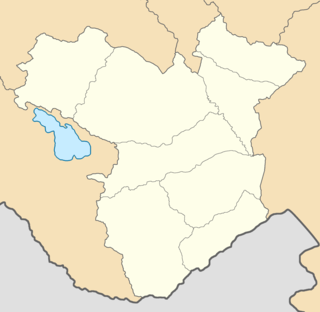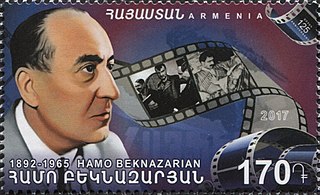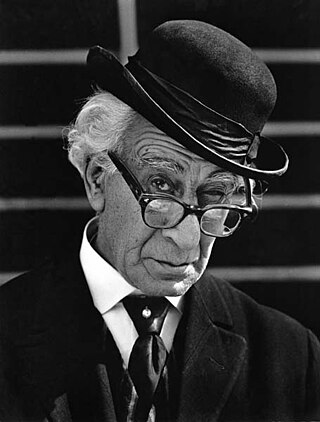
The First Republic of Armenia, officially known at the time of its existence as the Republic of Armenia, was an independent Armenian state that existed from May 1918 to December 2 1920 in the Armenian-populated territories of the former Russian Empire known as Eastern or Russian Armenia. The republic was established in May 1918, with its capital in the city of Yerevan, after the dissolution of the short-lived Transcaucasian Democratic Federative Republic. It was the first Armenian state since the Middle Ages.

Andranik Ozanian, commonly known as General Andranik or simply Andranik; 25 February 1865 – 31 August 1927), was an Armenian military commander and statesman, the best known fedayi and a key figure of the Armenian national liberation movement. From the late 19th century to the early 20th century, he was one of the main Armenian leaders of military efforts for the independence of Armenia.

Garegin Ter-Harutyunyan, better known by his nom de guerreGaregin Nzhdeh, was an Armenian statesman, military commander and nationalist political thinker. As a member of the Armenian Revolutionary Federation, he was involved in the national liberation struggle and revolutionary activities during the First Balkan War and World War I and became one of the key political and military leaders of the First Republic of Armenia (1918–1921). He is widely admired as a charismatic national hero by Armenians.

The Armenian-Azerbaijani war (1918–1920) was a conflict that took place in the South Caucasus in regions with a mixed Armenian-Azerbaijani population, broadly encompassing what are now modern-day Azerbaijan and Armenia. It began during the final months of World War I and ended with the establishment of Soviet rule.

The Republic of Mountainous Armenia, also known as simply Mountainous Armenia, was an anti-Bolshevik Armenian state roughly corresponding with the territory that is now the present-day Armenian provinces of Vayots Dzor and Syunik, and some parts of the present-day Republic of Azerbaijan in the west. It was established by military commander and Armenian political thinker Garegin Nzhdeh and his allies with the support of local guerrilla forces, following the suppression of the February Uprising in April 1921. It was not recognized by any country but existed until mid-July of the same year.

The Elizavetpol Governorate, also known after 1918 as the Ganja Governorate, was a province (guberniya) of the Caucasus Viceroyalty of the Russian Empire, with its capital in Yelisavetpol. The area of the governorate stretched 38,922.43 square versts and was composed of 1,275,131 inhabitants in 1916. The Elizavetpol Governorate bordered the Erivan Governorate to the west, the Tiflis Governorate and Zakatal Okrug to the north, the Dagestan Oblast to the northeast, the Baku Governorate to the east, and Iran to the south.

Hamo Beknazarian, also known as Hamo Bek-Nazarov or Amo Bek-Nazarian, was a Soviet Armenian film director, actor and screenwriter.

Pepo is a 1935 Soviet drama film based on Gabriel Sundukyan's 1876 play of the same name, scripted and directed by Hamo Beknazarian, with music composed by Aram Khachaturian. Considered the 'most outstanding' film in Soviet cinema before the outbreak of World War II, the film has gained international recognition and has come to represent Armenian culture abroad.

Gurgen Mahari was an Armenian writer and poet. His most significant works include the semi-autobiographical novella Barbed Wires in Blossom (1968) and the novel Burning Orchards (1966), which is set in the writer's hometown of Van on the eve of the Armenian genocide.

Azerbaijanis in Armenia numbered 29 people according to the 2001 census of Armenia. Although they have previously been the biggest minority in the country according to 1831–1989 censuses, they are virtually non-existent since 1988–1991 when most fled or were forced out of the country as a result of the tensions of the First Nagorno-Karabakh War to neighboring Azerbaijan. The UNHCR estimates that the current population of Azerbaijanis in Armenia to be somewhere between 30 and a few hundred people, with most of them living in rural areas as members of mixed couples, as well as elderly or sick. Most of them are reported to have changed their names to maintain a low profile to avoid discrimination.
Gurgen Vazgen Engibaryan is a former footballer who played as a midfielder.

The May Uprising was a coup d'état attempt by the Armenian Bolsheviks that started in Alexandropol on May 10, 1920. It was eventually suppressed by the Armenian government on May 14 and its leaders executed. Although the revolt failed, Armenia was Sovietized after the 11th Army of Soviet Russia invaded the country in November 1920 and the Turkish Nationalists occupied the western half of the country. The revolt and its executed leaders were praised during the Soviet period from 1920 until the late 1980s, when the Karabakh movement began and anti-Soviet sentiment rose in Armenia – The revolt remains a controversial topic in Armenia.

Amasi Martirosyan was an Armenian film director, screenwriter and actor.
Karo is a 1937 adventure-war film directed by Artashes Hay-Artyan and S. Taits and starring Avet Avetisyan, Moko Hakobyan and Ori Buniatyan

The Red Army invasion of Armenia was a military campaign which was carried out by the 11th Army of Soviet Russia from September to 29 November 1920 in order to install a new Soviet government in the First Republic of Armenia, a former territory of the Russian Empire. The invasion coincided with two concurrent events, the Turkish invasion, as well as the anti-government insurrection which was staged by the local Armenian Bolsheviks in the capital, Yerevan, and other cities and populated places within the country. The invasion led to the dissolution of the First Republic of Armenia and the establishment of the Armenian Soviet Socialist Republic.
Eduard Gaikovich Abalov (Abalyan) (Russian: Эдуа́рд Га́йкович Аба́лов (Абаля́н), Armenian: Էդուարդ Աբալյան); 7 October 1927 – 5 August 1987) was a Soviet film actor and director.
Zangezur is a historical and geographical region in Eastern Armenia. Zangezur may also refer to:

The Zangezur uezd was a county (uezd) of the Elizavetpol Governorate of the Russian Empire with its administrative center in Gerusy from 1868 until its formal abolition and partition between the Soviet republics of Armenia and Azerbaijan in 1921. The area of the Zangezur uezd corresponded to most of the contemporary Syunik province of Armenia, and Lachin, Gubadly, Zangilan, and Shusha districts of Azerbaijan.
Zangezur is a historical and geographical region in Eastern Armenia on the slopes of the Zangezur Mountains which largely corresponds to the Syunik Province of the Republic of Armenia. It was ceded to Russia by Qajar Iran according to the Treaty of Gulistan in 1813. In Soviet times, the Goris, Kapan, Meghri and Sisian regions of the Armenian SSR were located within Zangezur, which in 1995 became part of the Syunik Province of Armenia.













